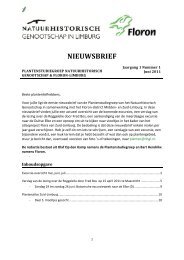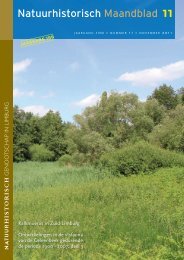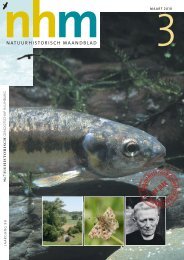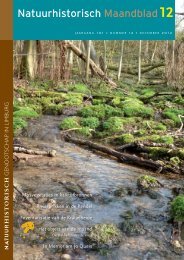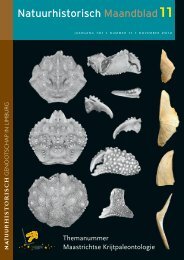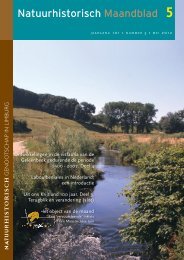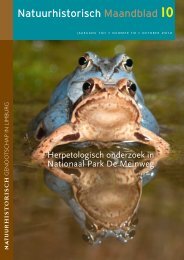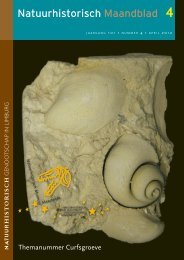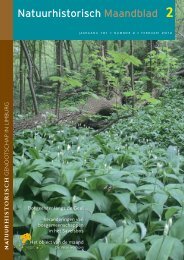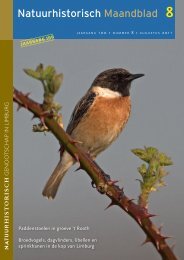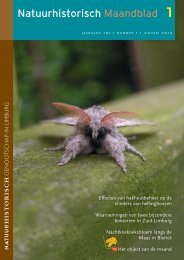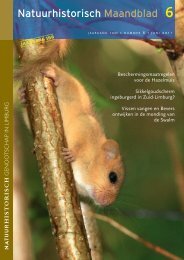nhm 07 juli2012 - Natuurhistorisch Genootschap in Limburg
nhm 07 juli2012 - Natuurhistorisch Genootschap in Limburg
nhm 07 juli2012 - Natuurhistorisch Genootschap in Limburg
You also want an ePaper? Increase the reach of your titles
YUMPU automatically turns print PDFs into web optimized ePapers that Google loves.
130 juli 2012 jaargang 101 | 7 natuurhistorisch maandblad<br />
Solabio. Speciale dank gaat uit naar Arnold Bakker, Jan Jeucken, Jöran<br />
Janse, Alex Kloor, Nils van Kessel, Douwe Schut en Gert Hoogerwerf voor<br />
hun hulp bij het verzamelen van DNA-monsters. De genetische analyses<br />
zijn uitgevoerd door Dr. Jorg Plötner en Dr. Torsten Ohst van de Hum-<br />
Summary<br />
ALIEN MARSH FROGS IN SOUTHERN<br />
LIMBURG<br />
Dur<strong>in</strong>g field studies <strong>in</strong> 2004 and 2005, relatively<br />
large Water frogs, whose morphological<br />
characteristics and habitat differed<br />
from those of native Marsh frog (Pelophylax<br />
ridibundus), were seen at several locations<br />
<strong>in</strong> Southern <strong>Limburg</strong>, The Netherlands.<br />
Genetic analyses of mtDNA of one specimen<br />
revealed a southern Balkanic orig<strong>in</strong>,<br />
which led to a more elaborate study of the<br />
identity of Water frogs <strong>in</strong> Southern <strong>Limburg</strong>.<br />
Recent studies <strong>in</strong> Germany and Belgium<br />
have shown that these alien Water frogs<br />
have to be regarded as an <strong>in</strong>vasive species<br />
threaten<strong>in</strong>g native amphibian populations.<br />
The present study exam<strong>in</strong>ed the distribution<br />
of alien Water frogs <strong>in</strong> the Southern<br />
<strong>Limburg</strong> region, which is the native distribution<br />
area of two threatened amphibian<br />
species, Midwife toad (Alytes obstetricans)<br />
and Yellow-bellied toad (Bomb<strong>in</strong>a variegata).<br />
We sampled and analysed mtDNA of 91<br />
frogs from thirteen study sites. Forty-six<br />
percent of the total sample (n=42) appeared<br />
to be Marsh Frog of foreign orig<strong>in</strong>, all but<br />
one orig<strong>in</strong>at<strong>in</strong>g from the southern Balkans.<br />
Alien frogs were collected at six of the thirteen<br />
sites. The status of native Marsh frog<br />
along the river Meuse is discussed.<br />
Ten percent of the total sample<br />
(n=8) appeared to be <strong>in</strong>fected with<br />
Batrachochytrium dendrobatidis, the fungus<br />
which causes the <strong>in</strong>fectious disease<br />
chytridiomycosis.<br />
Three sites with alien Marsh frogs are situated<br />
with<strong>in</strong> the native distribution area<br />
of Midwife toad and Yellow-bellied toad,<br />
which implies that the <strong>in</strong>vasive alien Water<br />
Frogs represent a high risk and may have<br />
serious negative impacts on the already<br />
threatened populations of Midwife toad<br />
and Yellow-bellied toad, through predation,<br />
food- and habitat competition and the<br />
spread<strong>in</strong>g of diseases like chytridiomycosis.<br />
Therefore, populations of alien Water frogs<br />
should be managed, preferably by eradicat<strong>in</strong>g<br />
exist populations.<br />
Literatuur<br />
boldt-universiteit Berlijn. Dank aan Martijn<br />
Dorenbosch en Nils van<br />
Kessel voor het kritisch doornedoornemen van het manuscript.<br />
l BoSCH J, i. MarTÍNEZ-SolaNo & M. garCÍa-ParÍS,<br />
2001. Evidence of a chytrid fungus <strong>in</strong>fection <strong>in</strong>volved<br />
<strong>in</strong> the decl<strong>in</strong>e of the common midwife toad<br />
(Alytes obstetricans) <strong>in</strong> protected areas of central<br />
Spa<strong>in</strong>. Biological Conservation 97 (3): 331–337.<br />
l CrEEMErS, r., 2011. Brulkikkers <strong>in</strong> Baarlo 2010-2011.<br />
Sticht<strong>in</strong>g RAVON, Nijmegen.<br />
l CroMBagHS, B.H.J.M., 2011. De brulkikker <strong>in</strong> Baarlo.<br />
Voortgangsverslag elim<strong>in</strong>atie van een populatie<br />
brulkikkers Lithobates catesbeianus <strong>in</strong> een particuliere<br />
parktu<strong>in</strong> <strong>in</strong> Baarlo. Natuurbalans - Limes Divergens<br />
BV, Nijmegen.<br />
l CroMBagHS, B. & W. BoSMaN (red.), 2006. Bescherm<strong>in</strong>gsplan<br />
Geelbuikvuurpad en Vroedmeesterpad<br />
<strong>in</strong> <strong>Limburg</strong> 2006-2010. Natuurbalans – Limes Divergens<br />
& Sticht<strong>in</strong>g RAVON, Nijmegen.<br />
l DaSZaK, P., a. a. CUNNiNgHaM & a. D. HyaTT, 2003.<br />
Infectious disease and amphibian population decl<strong>in</strong>es.<br />
Diversity and Distributions 9 (2): 141 – 150.<br />
l FEliX, r.P.W.H. & M. BooNMaN, 2004. Beschermde<br />
flora en fauna A2-Beatrixhaven Maastricht 2004.<br />
Natuur<strong>in</strong>ventarisatie ten behoeve van ontheff<strong>in</strong>g<br />
op de Flora- en faunawet. Bureau Natuurbalans -<br />
Limes Divergens BV, Nijmegen.<br />
l garNEr, T. W. J., M. W. PErKiNS, P. goViNDaraJUlU,<br />
D. SEgliE, S. WalKEr, a. a. CUNNiNgHaM & M. C. FiSHEr,<br />
2006. The emerg<strong>in</strong>g amphibian pathogen Batrachochytrium<br />
dendrobatidis globally <strong>in</strong>fects <strong>in</strong>troduced<br />
populations of the North American bullfrog,<br />
Rana catesbeiana. Biology Letters 2 (3): 455 - 459.<br />
l gÜNTHEr, R., 1990. Die Wasserfrösche Europas.<br />
Die Neue Brehm-Bücherei. A. Ziemsen Verlag. Wittenberg<br />
Lutherstadt.<br />
l HEiJligErS, H.W.g., 2009. Poelkikker – Rana lessonae.<br />
In: H.J.M. van Buggenum, R.P.G. Geraeds &<br />
A.J.W. Lenders (red.): Herpetofauna van <strong>Limburg</strong>.<br />
Verspreid<strong>in</strong>g en ecologie van amfibieën en reptielen<br />
<strong>in</strong> de periode 1980-2008. Sticht<strong>in</strong>g Natuurpublicaties<br />
<strong>Limburg</strong>, Maastricht: 232-243.<br />
l HolSBEEK, G., J. MErgEay, H. HoTZ, J. PlÖTNEr, F.A.M.<br />
VolCKaErT & L. DE MEESTEr, 2008. A cryptic <strong>in</strong>vasion<br />
with<strong>in</strong> an <strong>in</strong>vasion and widespread <strong>in</strong>trogression <strong>in</strong><br />
the European water frog complex: consequences of<br />
uncontrolled commercial trade and weak <strong>in</strong>ternational<br />
legislation. Molecular Ecology 17: 5023-5035.<br />
l KraUS, F., 2009. Alien Reptiles and Amphibians:<br />
A Scientific Compendium and Analysis. Spr<strong>in</strong>ger,<br />
New York.<br />
l laUFEr, H. & a. SaNDTE, 2003/2004. H<strong>in</strong>weise auf<br />
Konkurrenz zwischen Nordamerikanischem Och-<br />
senfrosch (Rana catesbeiana) und e<strong>in</strong>heimischen<br />
Grünfroschen bei Karlsruhe (Baden-Würtemberg).<br />
Herpetofauna 25 (143): 17-26.<br />
l lENDErS, a.J.W., 2009. Groene kikker complex<br />
- Rana esculenta synklepton. In: H.J.M. van Buggenum,<br />
R.P.G. Geraeds & A.J.W. Lenders (red.): Herpetofauna<br />
van <strong>Limburg</strong>. Verspreid<strong>in</strong>g en ecologie<br />
van amfibieën en reptielen <strong>in</strong> de periode 1980-<br />
2008. Sticht<strong>in</strong>g Natuurpublicaties <strong>Limburg</strong>, Maastricht:<br />
216-231.<br />
l lENDErS, a.J.W. & W. JaNSEN, 2009. Meerkikker<br />
– Rana ridibunda. In: H.J.M. van Buggenum, R.P.G.<br />
Geraeds & A.J.W. Lenders (red.): Herpetofauna van<br />
<strong>Limburg</strong>. Verspreid<strong>in</strong>g en ecologie van amfibieën<br />
en reptielen <strong>in</strong> de periode 1980-2008. Sticht<strong>in</strong>g Natuurpublicaties<br />
<strong>Limburg</strong>, Maastricht: 256-267.<br />
l lyMBEraKiS, P., N. PoUlaKaKiS, g. MaNTHaloU, C.S.<br />
TSigENoPoUloS, a. MagoUlaS & M. MyloNaS, 20<strong>07</strong>. Mitochondrial<br />
phylogeography of Rana (Pelophylax)<br />
populations <strong>in</strong> the eastern mediterranean region.<br />
Molecular Phylogenetics and Evolution, 44(1): 115-<br />
125.<br />
l MErgEay, J., g. HolSBEEK, F. VolCKaErT & l. DE MEES-<br />
TEr, 2011. Rout<strong>in</strong>ematige screen<strong>in</strong>g van genetische<br />
barcodes bij groene kikkers legt verborgen <strong>in</strong>vasies<br />
bloot. De Levende Natuur 112 (2): 66-72.<br />
l oHST, T., 2009. Allochthone Wasserfrösche <strong>in</strong><br />
Deutschland. Hybridschwarmbildungen zwischen<br />
Wasserfröschen des Rana kl. esculenta-Komplexes<br />
und e<strong>in</strong>geschleppten Formen. Südwestdeutscher<br />
Verlag für Hochschulschriften, Saarbrücken.<br />
l PlÖTNEr, J. & T. oHST, 2001. New hypotheses on<br />
the systematics of the western Palearctic water<br />
frog complex (Anura, Ranidae). Zool. Reihe 77: 5-21.<br />
l SoWig, P., J. PlÖTNEr & K. FriTZ, 20<strong>07</strong>. Seefrosch Rana<br />
ridibunda. In: H. Laufer, K. Fritz & P. Sowig (Hrsg.).<br />
Die Amphibien und Reptilien Baden-Württembergs.<br />
Eugen Ulmer KG, Stuttgart: 487-500.<br />
l SPiTZEN - VaN DEr SlUiJS, a. M. & r. ZolliNgEr, 2010.<br />
Risk assessment on the American bullfrog and the<br />
fungus Batrachochytrium dendrobatidis. Sticht<strong>in</strong>g<br />
RAVON, Nijmegen.<br />
l SPiTZEN - VaN DEr SlUiJS, a. M. & W. BoSMaN, 2011.<br />
Onderzoek naar effecten van de schimmel B. dendrobatidis<br />
op de Geelbuikvuurpad, Vroedmeesterpad<br />
en Vuursalamander. Sticht<strong>in</strong>g RAVON, Nijmegen.<br />
l WiJNaNDS, H.E.J., 1992. Meerkikker. In: J.E.M. van<br />
der Coelen, (red.). Verspreid<strong>in</strong>g en ecologie van<br />
amfibieën en reptielen <strong>in</strong> <strong>Limburg</strong>. <strong>Natuurhistorisch</strong><br />
<strong>Genootschap</strong> <strong>in</strong> <strong>Limburg</strong> / Sticht<strong>in</strong>g RAVON,<br />
Maastricht / Nijmegen: 195-199.




